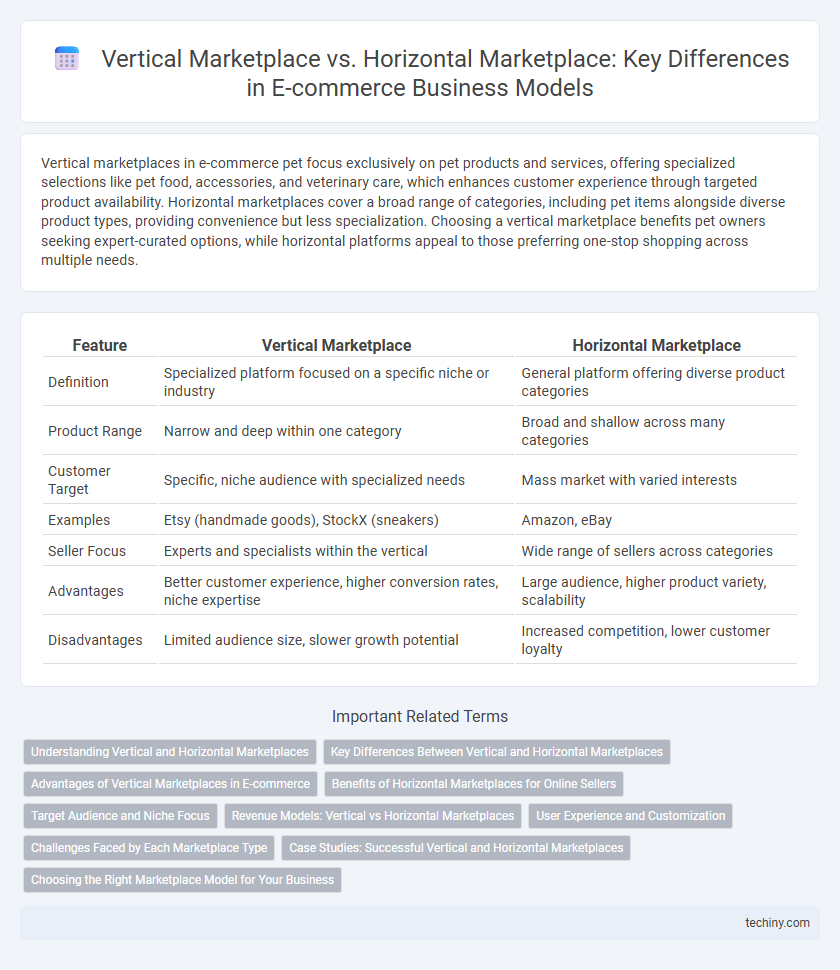Vertical marketplaces in e-commerce pet focus exclusively on pet products and services, offering specialized selections like pet food, accessories, and veterinary care, which enhances customer experience through targeted product availability. Horizontal marketplaces cover a broad range of categories, including pet items alongside diverse product types, providing convenience but less specialization. Choosing a vertical marketplace benefits pet owners seeking expert-curated options, while horizontal platforms appeal to those preferring one-stop shopping across multiple needs.
Table of Comparison
| Feature | Vertical Marketplace | Horizontal Marketplace |
|---|---|---|
| Definition | Specialized platform focused on a specific niche or industry | General platform offering diverse product categories |
| Product Range | Narrow and deep within one category | Broad and shallow across many categories |
| Customer Target | Specific, niche audience with specialized needs | Mass market with varied interests |
| Examples | Etsy (handmade goods), StockX (sneakers) | Amazon, eBay |
| Seller Focus | Experts and specialists within the vertical | Wide range of sellers across categories |
| Advantages | Better customer experience, higher conversion rates, niche expertise | Large audience, higher product variety, scalability |
| Disadvantages | Limited audience size, slower growth potential | Increased competition, lower customer loyalty |
Understanding Vertical and Horizontal Marketplaces
Vertical marketplaces specialize in specific industries or product categories, offering tailored shopping experiences with expert product selections and niche customer targeting. Horizontal marketplaces provide a broad range of products across multiple categories, attracting diverse customer segments and increasing overall market reach. Understanding the strategic focus of vertical versus horizontal marketplaces helps businesses optimize product offerings and enhance customer engagement in competitive e-commerce environments.
Key Differences Between Vertical and Horizontal Marketplaces
Vertical marketplaces specialize in specific product categories or industries, offering curated selections and targeted services that cater to niche audiences, such as electronics or fashion. Horizontal marketplaces provide a wide variety of products across multiple categories, aiming to attract a broad customer base by offering everything from groceries to electronics in one platform. The key differences lie in product specialization, customer segmentation, and marketing strategies, with vertical marketplaces focusing on depth and expertise while horizontal marketplaces prioritize breadth and convenience.
Advantages of Vertical Marketplaces in E-commerce
Vertical marketplaces in e-commerce offer specialized product categories that enhance customer experience by providing expert knowledge, tailored search options, and curated selections. These platforms enable sellers to target niche markets more effectively, resulting in higher conversion rates and customer loyalty. Vertical marketplaces also facilitate better inventory management and competitive pricing due to their focused supplier base and domain expertise.
Benefits of Horizontal Marketplaces for Online Sellers
Horizontal marketplaces offer online sellers access to a diverse customer base across multiple product categories, increasing potential sales and brand exposure. These platforms streamline inventory management by consolidating various goods in one place, reducing marketing costs and operational complexity. Sellers benefit from enhanced data analytics and robust customer feedback systems, enabling strategic insights and improved product offerings.
Target Audience and Niche Focus
Vertical marketplaces specialize in a specific industry or product category, targeting a niche audience with tailored offerings that enhance customer experience and increase conversion rates. Horizontal marketplaces serve a broad, diverse audience by providing a wide range of products across multiple categories, appealing to general consumers seeking variety and convenience. Understanding the target audience and niche focus is crucial for e-commerce businesses to optimize marketing strategies and improve shopper engagement.
Revenue Models: Vertical vs Horizontal Marketplaces
Vertical marketplaces generate revenue primarily through specialized commission fees, subscription plans, and premium services tailored to niche industries, enhancing customer targeting and retention. Horizontal marketplaces maximize revenue by leveraging broad product categories, utilizing advertising, listing fees, and transaction commissions across diverse sectors to attract high-volume traffic. Both models optimize monetization strategies based on market scope, with vertical platforms focusing on depth and customer loyalty, while horizontal platforms capitalize on scale and variety.
User Experience and Customization
Vertical marketplaces enhance user experience by offering specialized product selections tailored to specific customer needs, enabling deeper customization and personalized recommendations. Horizontal marketplaces provide a broad array of products across multiple categories, prioritizing convenience and variety, but may sacrifice the depth of product expertise and tailored user interfaces. Customization in vertical marketplaces often results in more efficient search functionalities and curated content, improving engagement and conversion rates compared to the generalized experience in horizontal platforms.
Challenges Faced by Each Marketplace Type
Vertical marketplaces face challenges such as limited customer base and inventory diversity, making it difficult to scale rapidly and attract a wide audience. Horizontal marketplaces struggle with high competition among diverse product categories, often resulting in fragmented customer experiences and difficulties in maintaining quality control. Both types must invest heavily in technology and logistics to optimize user engagement and ensure seamless transactions.
Case Studies: Successful Vertical and Horizontal Marketplaces
Vertical marketplaces like StockX and Reverb thrive by specializing in niche products, delivering curated experiences and building strong communities focused on sneakers and musical instruments respectively. Horizontal marketplaces such as Amazon and eBay succeed through vast product diversity and extensive buyer-seller networks, optimizing convenience and competitive pricing. Case studies reveal that vertical marketplaces excel in customer loyalty and expert positioning, while horizontal marketplaces dominate in scalability and variety.
Choosing the Right Marketplace Model for Your Business
Choosing the right marketplace model hinges on your business goals, product range, and target audience. Vertical marketplaces specialize in a specific niche, offering deep product expertise and targeted customer engagement, which can drive higher conversion rates in specialized sectors. Horizontal marketplaces provide broad product categories, attracting diverse customer segments and allowing businesses to reach a larger audience but may face stiffer competition and lower buyer intent.
Vertical Marketplace vs Horizontal Marketplace Infographic

 techiny.com
techiny.com